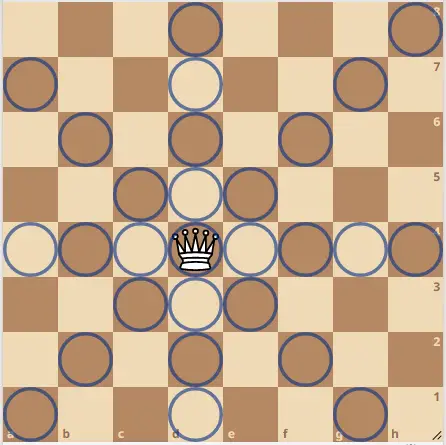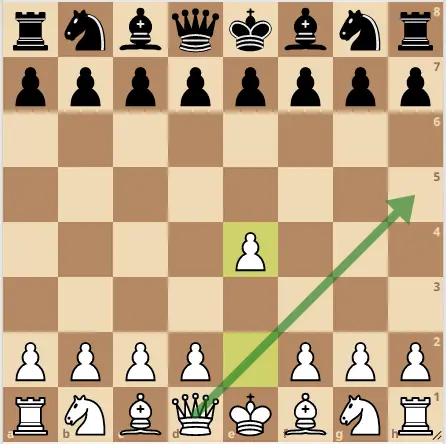At the start of a chess game, the queen sits next to the king on the d1 square for white and the d8 square for black. You may have heard that the queen is the most powerful piece on the chess board and that losing it significantly reduces the force of your army. But how truthful is this?
In this article, we will discuss the number of spaces the queen can move and deduce whether or not it is in fact the most powerful piece on the chess board. Let’s dive in.
How Many Spaces Can The Queen Move In Chess?
The queen can move any number of spaces on the chess board, in any direction in a straight line. It has the power of the rook and bishop combined. In other words, it can move diagonally, up, down and sideways.
The queen has a lot more space to move from the center of the board than if it was on the edge or in the corner. For example, the queen has 27 possible spaces to move from the center, 21 spaces if it is on the edge, and 21 spaces from in the corner.
The queen has 27 possible spaces to move on the chess board from the center

The queen has 21 possible spaces to move from any four edges of the chess board

The queen has 21 possible spaces to move from any four corners of the chess board

Out of all the pieces on the chess board, the queen controls the most number of squares thereby making it the most powerful piece.
Should You Put Your Queen In The Center?
The queen is very powerful from the center of the board as it controls a total of 27 squares. However, you need to know the right moment to bring your queen out in the center of the board.
If you bring out your queen too early in the game, chances are, it would get chased away by the opposing side. Your opponent will gain valuable tempo off your queen in the opening. This means, your opponent will attack your queen while simultaneously developing his own pieces.
For example, in the Scandinavian Defense chess opening, white gains a tempo off the black queen by developing his knight to c3.
Opening moves: 1.e4 d5 2.exd5 Qxd5 3.Nc3
The black queen is forced to retreat, thereby losing a tempo in the opening as white gets the turn to develop another one of his pieces.

The Scandinavian Defense is a popular opening choice for Black. In fact, Black is doing perfectly fine here and just needs to prioritize his kingside development. In most other openings however, it would be bad to bring out your queen in the center so early.
It’s important to note that black could have avoid capturing the pawn on d5 with his queen. Instead, he could have developed his knight to f6 and recapture the pawn at a later time. This prevents white from gaining the tempo.
Black will recapture with the knight instead of the queen.

Centralizing The Queen
Centralizing the queen is best done in the endgame, and in some middlegame positions. The queen is at its most powerful in the endgame as it has the ability to gobble up almost every single one of its opponent’s pawns.
The pawns are dangerous in the endgame. If you can get one of your pawns to promote to a queen on the last rank, there is a good chance you will checkmate the king and win the game.
By centralizing the queen, you take control of key squares in the position. This means stopping a pawn from promoting, or cutting off the opponent’s king from accessing key squares.
The queen is also a very good attacker and defender of pieces. It can defend or attack up to 8 pieces at once. In the position below, the black queen is attacking 6 of white’s pieces from the center.

How Many Spaces Can The Queen Move From Its Starting Position
In the starting position of the chess game, the queen doesn’t have any spaces to move as it is blocked by its own pieces. In order for the queen to have space to move, the pawns must advance to the center of the board so that lines can open up for the queen.
Pawn to e4 opens up the d1-h5 diagonal for the white queen.

Now the queen has 4 possible squares to move. The more pawns that are advanced in the center, the more space and lines that are open up for the queen to move.
For example, if white pushed his d and c-pawn 2 squares forward, then the queen will have more spaces to move.
However, you should be careful when opening lines for your pieces. You don’t want to open up the position too much when your king is still uncastled. It’s best to prioritize king safety and then open up the position as you see fit.
How Important Is Space In Chess?
Gaining space is a strategy many grandmasters love to use. With more space, you have more room for your pieces to move about freely.
The side with less space will not have much options. Their pieces will be passive and they will have a miserable time playing.
The way to gain space is to simply advance your pawns forward, either in the center or on the flanks. In most positions, the player with the spatial advantage has enough time to execute his strategy by manouvring his pieces onto the right squares. When the time is right, he can pry open the position and penetrate his pieces into the opponent’s territory.
Final Verdict
The queen controls the most number of spaces on a chess board, thereby making it the most powerul piece in chess. The more space that is created on the chess board is the more powerful the queen becomes.
To create more space for the queen and your other pieces to move, you simply advance your pawns further up the board into your opponent’s territory.
However, you should be mindful when doing this. If you overextend, your pawns can become targets of attack in the endgame.


